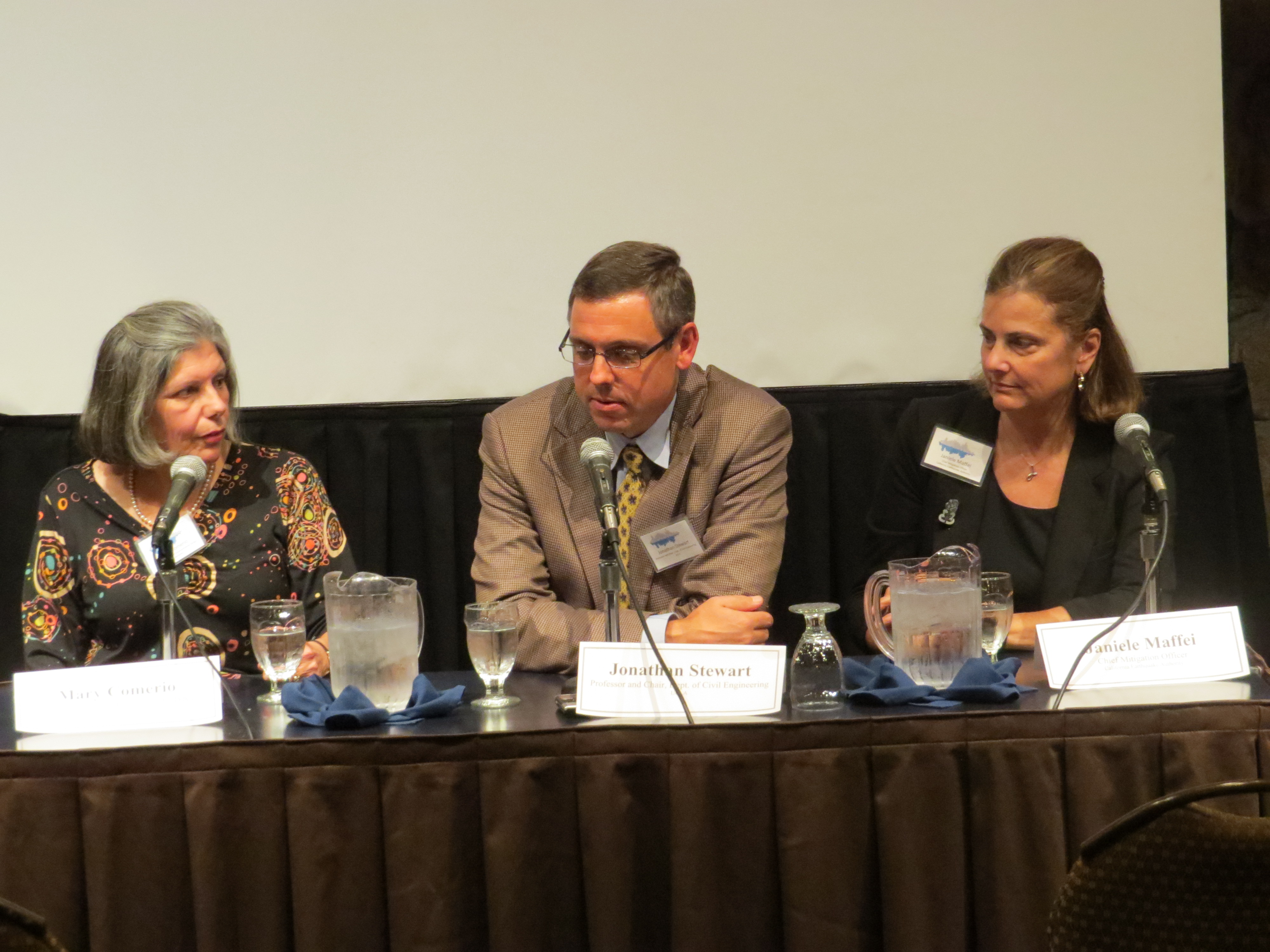Both of California’s major regions, Los Angeles and the Bay Area, sit on active earthquake faults. How resilient will they be when the next one hits? Together, three panelists offered insights on just how many systems and approaches come together to form earthquake preparedness — or lack thereof — in California. Consider the wide range of activities currently underway: buying and selling insurance, funding and constructing building reinforcements made of plywood and nails, political strategizing about water bonds, retrofitting large public infrastructure like highways, airports, and water pipes; general plan and zoning updates; housing inventories.
The panel brought together two researchers with divergent backgrounds along with a leading practitioner. These were Mary Comerio, Professor at the College of Environmental Design in Berkeley and a leading expert on the social, economic, and built environment impacts of earthquakes; Jonathan P. Stewart, an expert on geotechnical earthquake engineering and seismology, and Janiele Maffei, the Chief Mitigation Officer for the California Earthquake Authority.
The Panelists
Janiele offered an often literal nuts-and-bolts view of earthquake preparedness. She showed the types of structures that are mostly likely to collapse, and described the kinds of mitigations that can be done to strengthen them. Her many photos of collapsed highways, houses halfway buried due to ground failure, and unreinforced masonry reduced to piles of brick reminded the audience of the danger earthquakes pose and the damage they can wreak. She described the state programs her agency administers to fund building reinforcements, provide insurance, and encourage seismic assessments, as well as state laws that require the retrofit of public infrastructure, schools, and hospitals.
While Janiele’s talk focused on past damage, Jonathan’s talk centered on a threat that is unlike anything the state has yet experienced. As he noted, this makes it harder for the public and elected officials to understand the danger and prepare for it. The threat: salt water. The main source of much of central and southern California’s water, the State Water Project, sources its water from the Bay Delta, the freshwater river delta fed by the Sacramento and San Joaquin rivers. While the delta is naturally a freshwater marsh, over time much of it has been reclaimed for agriculture, with 1100 miles of levees holding water out of over 50 reclaimed islands. The levees are weak, and an earthquake would destroy many of them. In the event of an earthquake, delta water would fill reclaimed islands. Because the space within the delta islands exceeds the immediately available volume of fresh water, this would cause salt water to be drawn in from the San Francisco Bay, contaminating the State Water Project. Jonathan showed a video animation of this happening.
Finally, Mary Comerio gave a view from architecture and urban planning. She talked about the long view: preparedness as a planning process with three phases: Before the Disaster, Disaster Response, and After the Disaster. How can government better handle each of these phases? Such a question might be the focus of a General Plan Community Safety Element, as it is in San Francisco. Comerio talked about the need for transparent definitions: definitions of hazard, categories of usable housing, and clear goals for the restoration. These form, in effect, the government’s intention and they enable the government and society to hold itself accountable. Comerio showed some examples of plans, policies, and maps. (Read more.)
Common Themes
On the whole, California is probably uniquely resilient to earthquakes because of our diverse and relatively thorough response to the earthquakes we’ve experienced. We’ve engaged in extensive building code revisions, seismic retrofits on a massive scale, and sophisticated planning and outreach efforts. We’re home to major research institutions that interrogate our successes and failures when earthquakes hit and inform better policies to protect us against damage and loss.
On the other hand, because earthquakes are relatively infrequent, our response to them is strongly informed by our singular experiences with them. After an earthquake, seismologists like Jonathan do reconnaissance, collect data, and try to better understand what happened. All three panelists noted that all the legislation that protects us in earthquakes has been passed the year after a big earthquake, usually to address damages that earthquake caused or vulnerabilities it exposed. Where we fall short is in addressing problems that we know exist but we have not yet experienced, like amplified shaking in soft soil regions of the Bay Area or the collapse of Bay Delta levees or a daytime earthquake in a major urban region.
Summary by Diana Benitez and Herbie Huff
